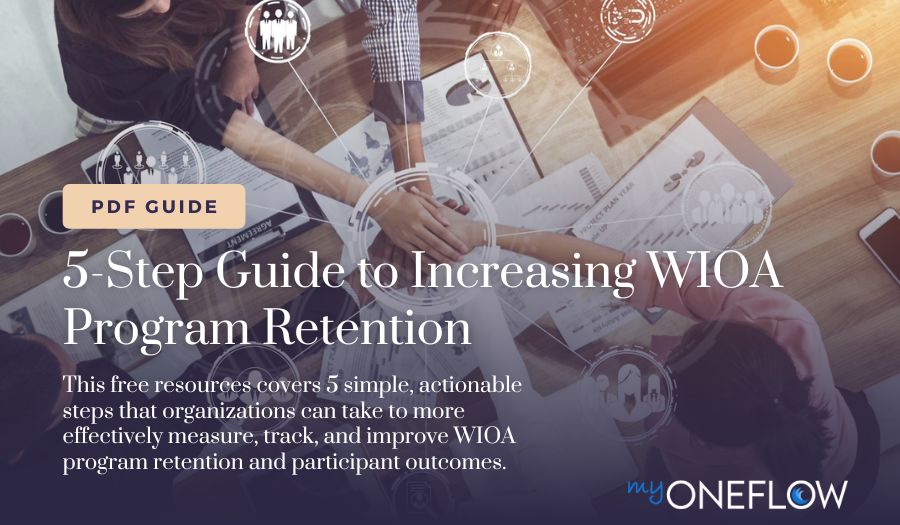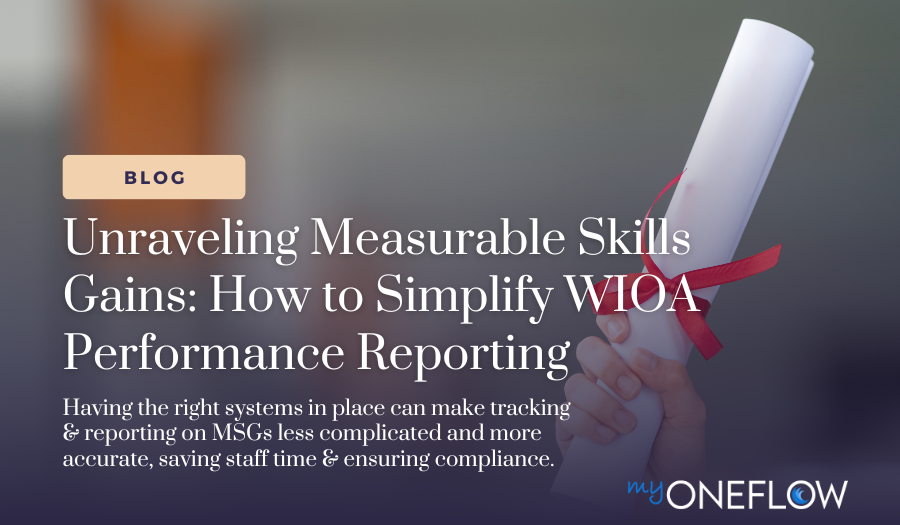5-Step Guide to Increasing WIOA Program Retention
Maintaining program retention is one of the leading challenges faced by WIOA service providers. Most outcomes tracked for WIOA performance reporting...
5 min read
myOneFlow Staff Aug 27, 2025 12:12:58 PM

Workforce development programs are in a period of change and unpredictability. With ongoing conversations about WIOA funding and pending legislative decisions, the future of workforce services remains unclear. Yet even amidst the uncertainty, one resource consistently strengthens your position: data.
PIRL reporting showcases comprehensive program outcomes on a quarterly basis, yet many organizations treat this information as mere compliance paperwork. This perspective misses a critical opportunity. Your data tells compelling stories of transformation—individuals gaining employment, earning higher wages, and breaking cycles of poverty. These stories become the foundation for advocacy that can secure funding and demonstrate measurable return on investment.
Workforce leaders who embrace data-driven advocacy position their organizations to stand out and succeed. When legislators debate budget allocations, organizations armed with concrete evidence of impact win resources. When stakeholders question the effectiveness of a program, clear metrics provide undeniable proof of success. Your participant outcomes, employment rates, and earnings data create powerful narratives that influence decision-makers.
This blog will cover how to transform routine PIRL submissions into strategic advocacy tools. We'll explore specific techniques for highlighting your program's value with a WIOA Impact Report, demonstrate how to leverage employment outcomes for maximum impact, and discuss advanced approaches that move beyond traditional reporting. The future of workforce development depends on leaders who can articulate their value through data. Your programs deserve recognition, funding, and support—and your data holds the key to securing all three.
High-quality data is essential for every workforce development organization. Reliable data not only underpins daily operations but also drives advocacy and helps secure the future of your programs. Here are three compelling reasons to prioritize data quality:
Strong data practices show your commitment to transparency and responsibility. Stakeholders—including legislators, funders, and community partners—are more likely to support your work when they trust your results.
Quality data goes beyond compliance—it proves the value your program brings to the community. This financial perspective is especially persuasive for those managing limited resources.
Data-backed stories are more impactful than general statements. When your narratives are grounded in precise, verified information, your case for program support becomes compelling and clear.
Prioritizing quality data is foundational for building confidence, showcasing your program’s value, and setting the stage for impactful advocacy.
Building a strong WIOA Impact Report begins with purposefully organizing your data to communicate program value and drive advocacy efforts. The following steps outline a structured approach workforce leaders can use to turn PIRL reporting into a strategic asset for funding and stakeholder engagement.
Begin by identifying the outcomes that best highlight your program’s impact. Focus on metrics that are meaningful to funders, policymakers, and partners:
Use your data to show how different program elements contribute to success. Comparisons help clarify where your approach delivers the greatest value:
Highlight the broader benefits of your work. Frame data in terms of community-wide impacts that resonate with stakeholders:
Enhance your report by combining numerical data with personal stories. Use data to frame the narrative, and include context to illustrate obstacles overcome and long-term change:
Present your findings in a format that suits each stakeholder. Legislators might focus on fiscal responsibility and economic growth, while employers are interested in workforce quality and local impact. Adjust your messaging to address the priorities of each group.
A thoughtfully constructed impact report transforms PIRL data from compliance documentation into a proactive advocacy tool. By following these steps, you put your data to work in support of sustainable funding, stronger partnerships, and continued program success.
Quarterly PIRL submissions provide a valuable retrospective look at program performance, but they represent a snapshot in time. To truly optimize service delivery and strengthen advocacy, workforce leaders must look beyond periodic reporting and embrace the power of real-time data. This shift from historical review to immediate insight allows for proactive adjustments that directly improve outcomes.
Real-time data provides a continuous and dynamic view of your operations, enabling faster and more informed decision-making. Instead of waiting months to identify a performance issue, you can spot trends as they emerge and intervene immediately. This capability is critical for adapting to changing labor market demands and participant needs.
Access to live information empowers your team to monitor progress against goals, manage caseloads more effectively, and personalize support for participants. When a client misses a check-in or falls behind in a training program, instant alerts allow case managers to provide timely assistance. This proactive approach leads to better participant engagement and higher completion rates.
Transitioning to a real-time data model involves adopting new tools and processes that enable immediate access to and analysis of information. The goal is to create a system where data is not just collected but actively used to guide daily operations.
By integrating these strategies, you can transform your data from a compliance requirement into a strategic asset. Real-time information fosters a culture of continuous improvement, where decisions are based on current evidence rather than past performance. This operational agility strengthens your programs and provides even more compelling evidence of your impact for advocacy efforts.
Quality data forms the foundation of any successful advocacy effort, building stakeholder trust and proving the value of your programs. Your PIRL reports contain the compelling narratives of participant success and economic contribution that resonate with decision-makers. By moving beyond quarterly submissions to embrace real-time data, you can refine service delivery and strengthen your advocacy with immediate, actionable insights.
myOneFlow is purpose-built to help workforce organizations manage their data, from PIRL reporting to real-time insights. With features like prebuilt PIRL templates that are autopopulated with participant information for easy export and submission, our platform streamlines compliance and empowers data-driven advocacy. Compare our package options to explore how we can support your work.

Maintaining program retention is one of the leading challenges faced by WIOA service providers. Most outcomes tracked for WIOA performance reporting...

Measurable Skills Gains (MSGs) are a fundamental aspect of evaluating participant progression in WIOA-funded programs and constitute a significant...

In an age of sleek software, automated processes, and personalized workflows, we expect a certain level of sophistication from our technology. We...